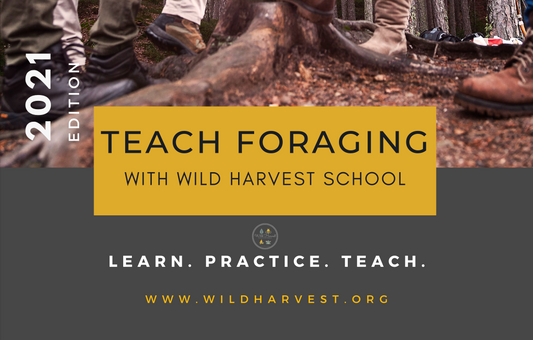
Selecting and Preparing Willow For Weaving
Basket making really is a cradle-to-grave skill. Baskets are used from birth as Moses baskets to carry newborns and then throughout life to collect wild food, cook in, eat from, shop with, sit on, right up until our death, where we can even be buried in a woven casket!In the UK our ancestors would have woven baskets from native plant materials such as: dried grass, bramble, willow and straw. The rule of thumb is that any long thin plant material you can wrap around your wrist once fully without snapping can be woven as a basket. Today we can also buy imported basket weaving materials such as cane (from a tropical palm) or raffia. At Wild Harvest School we teach willow basket weaving due to the easy availability and quick growing nature of willow in the wet UK. It is a plant you can readily find in the wild or that you can plant in your garden to raise a few willow whips yourself. We don't believe in importing tropical plants when nature provides us with native materials right here!
The willow used mostly in commercial basket weaving in the UK is ...
Black Maul a cultivar of Salix Triandra but most willow is ‘weavable'. The thin shoots of the willow tree are known as whips but once cut and dried we call them rods.
Choosing Willow for Weaving
You can buy rods already cut and dried, either with the bark stripped off (buff) or with the bark left on (brown). The difference is in both aesthetics and toughness to weave. If you are new to weaving and/or don't have much hand strength then its best to start with buff willow as its much easier to work. Green willow refers to undried willow that in theory could sprout life again if stuck in the ground. If you weave a basket from willow straight off the tree (green) it will shrink as it dries so distorting your baskets shape, this is why we usually work with willow that has been dried and then re-soaked. It has then pre-shrunk.
Size - for basket weaving purposes rods can be bought in bundles known as ‘bolts’ sized from 3 feet long up to nine feet long and sold in Kg. A 5kg bolt of 3ft willow is approximately £12 and contains 500 rods. You will need about 70 rods to make a simple round basket.To determine how long the rods should be for a particular basket weaving project use Pie - The only adult use of ‘pie’ (that abstract mathematical concept we learn at school) I have ever had is in basket weaving. To work out how long the willow rods should be for a particular basket diameter use the Pie formula of “circumference equals 3.14 times the diameter”. So for a one foot diameter basket you will need rods of slightly longer than 3 feet in length, for a three feet diameter basket you will need the nine foot rods. This is a rough guide but its better to have slightly longer rods than your desired circumference.
Disease - Any black marks on your willow rods indicate a disease the plant was suffering from when it was growing and these spots will be weak and prone to snapping as you weave. Discard rods with this on until you are confident enough to work with it.
Timing - If you are cutting the willow yourself - there is a season for cutting to be aware of. Traditionally this was between Michaelmas and Candlemas, basically over the winter months. The reason for this is because the sap is down then; it rises in the tree in Spring and when the sap is down the whips are not so rigid .Preparation of Willow ready to Weave into a Basket.Soaking - Assuming you have some dried willow rods from a supplier or have cut your own and left them to dry indoors somewhere or wrapped under a hedge for three weeks you are now ready to re-soak the willow ready to weave. The re-soaking of the dried willow makes it pliable; bendy enough again for weaving, you will not be able to weave a basket with dried willow it will simply snap. To soak the willow I use either my bath at home or a garden pond, a river will also be fine. If you are using a pond or a river I recommend tying the bolt with string and the other end of the string to a tree so it doesn’t float away. I weight the bolt down under the water by covering it in wet towels. The amount of soaking time depends on both the type and length of the willow. Buff willow, because there is no bark for the water to penetrate is soaked for a much shorter time, the rule of thumb is based on the length of the rods because he length of the rods determines the thickness at the butt ends that the water must penetrated. Three foot buff rods can be soaked for as little as one hour but six foot buff rods can take about 3 hours.With the brown willow (ie. bark on) the soaking time is much longer and the saying goes - one day per foot. So, a four foot bolt will take four days in the pond.
Mellowing - This isn't the end of the process however because after it’s bath the willow likes to mellow for a while - after you remove it from the bath/pond the willow works best if its wrapped in wet towels for a further amount of time proportionate to the soaking time ie. soak for an hour then mellow for an hour.
I always think of this part like the willow is lounging around in a dressing gown for a bit until its ready to work.
Anatomy of a rod - You will see that the rod is thicker at the base end, the end that was closest to the ground when it was growing, this is known as the butt, the topmost end, the thin end is known as the tip. Rods will have a natural curve to them, the inside curve is known as the belly, the outer curve is the back. It is useful when weaving to work with the natural shape of the rod and not bend it at an un-natural angle to itself or it can snap. Wild Harvest are producing a series of videos teaching each stage of basket weaving. On the videos we will talk about butts and tips when teaching weaving.
Cut - Dry - Soak - Mellow - Weave
More about Willow Weaving including how to make a fence in my book below...




